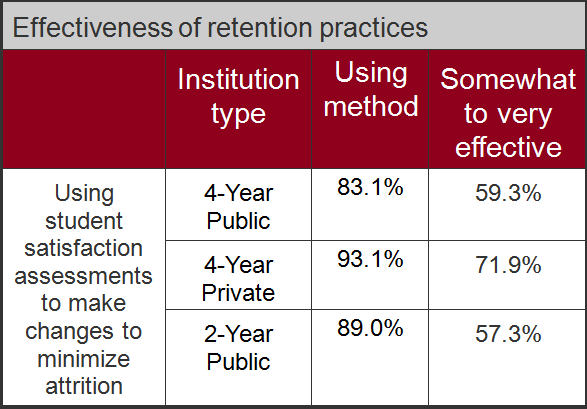enrollment
How can you turn college student satisfaction data into action planning?
The 2011 Student Retention Practices and Strategies Report indicates that while a large percentage of four-year public, four-year private, and two-year institutions are using satisfaction assessments to make changes to minimize attrition, a smaller percentage of these institutions feel that they are effective with actively using the data.

The struggle to effectively utilize the data on campuses is not uncommon. I have worked with institutions that are very diligent about surveying annually or every other year but do not use their assessment data as effectively as they would like. Furthermore, we have found that satisfaction actually may go down if you keep asking how satisfied students are but do nothing to respond to their feedback. “Data on the shelf” (or on your computer) have no power. The power comes when you use data to make improvements.
I have advised institutions of all types that they are more likely to be effective in using their satisfaction assessment results for improvement if they:
- Widely communicate the results on campus so everyone knows which areas are of top priority for improvement.
- Establish a team responsible for reviewing the data more closely and for taking action with the results.
- Conduct focus group sessions to learn more from students about the true meaning behind the numbers in the report.
My colleagues and I at Noel-Levitz are continuously working to assist institutions with using their results for campus improvement. This involves transitioning from simply gathering regular assessment data to a process that gathers student perspectives and uses that data to actively guide decision making and influence perceptions.
How does this process work on campus? That’s something that a pair of campus colleagues will illustrate in an upcoming Webinar, How to Assess Student Satisfaction and Priorities (Feb. 23).
Dr. Martha Nelson, associate vice president of academic affairs at Dominican University of California, and Dr. Samuel Hirsch, vice president for student affairs at Community College of Philadelphia, will share how satisfaction assessment has become a systematic activity to document student experiences for their institutions, identify issues for improvement, and identify actions that improve student satisfaction. A key element for both institutions has been the ability to monitor trends over time in order to document increases in student satisfaction as a result of their activities. They have also found the data to be beneficial for their accreditation requirements. The Community College of Philadelphia incorporates their satisfaction scores into their key performance indicators as part of their enrollment management plan. Dominican University produces detailed charts and graphs to report the results to their campus constituencies. Both campuses can cite specific enhancements they have made to their processes and procedures to better serve their students in high priority areas.
If you want to learn how to turn satisfaction data in to action plans that create a stronger student experience, I really encourage you to join me along with Dr. Nelson and Dr. Hirsch on February 23. It’s a free Webinar and you’ll have an opportunity to ask questions. Or feel free to contact me directly to discuss opportunities for your campus.
